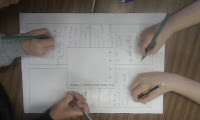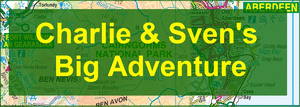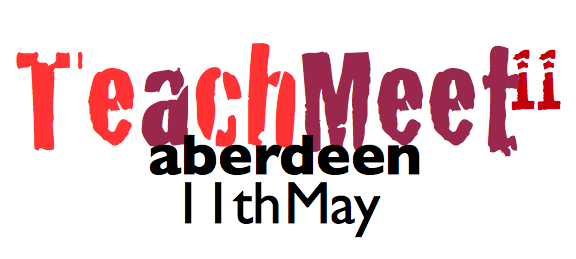I'd had a pretty full-on term and really needed a boost to lift my spirits and increase my motivation for the long days teaching, assessing, reflecting and planning. This boost came in the form of the Aberdeen Teachmeet.
I repeated my May presentation calling for teachers to become involved in an Aberdeenshire augmented reality channel to showcase children's work around the area. I also demonstrated the use of Issuu and the 'hilariously' titled Stickybits. Yes, insert captions that read 'Charlie Barrow showing off Stickybits' and such like.
Ian Simpson: Becoming Orson: Podcasting War Of The Worlds
Ian presented a fantastic piece proving that the umbrella of ICT clearly covers what we would traditionally call 'media'. Inspired by the famous Welles radio play War Of The World, Ian's lunchtime club pupils favoured the radio play genre over the celebrity music based programme pleasantly surprising Ian.
Using free audio software
Audacity and microphones bought on the cheap from the Pound Store, they began work on scripting and producing the radio play. That moment we all look forward to as teachers came when Ian walked in to the classroom to find his pupils experimenting with the springs from the back of a broken chair. They discovered that they could create some fantastic foley by dropping two springs on the floor and recording the sound.
Thank you Ian for sharing your inspiration and making us all wish that we were pupils in your class!
Nikki Stobie: Random name generator
In primary schools we rely heavily on tried and tested systems like using lolly pop sticks with names written on to randomly choose children for various reasons. While this has worked since before I can remember, it's always great to be able to take these ideas and modernise them, polishing them up with a little wow factor.
Nikki has found a great random name generator from
classtools.net. Insert the names of your pupils and choose from the typewriter or fruit machine. The flash based animation then generates one of the names at random to a big round of applause. Nice!
Mark Hay: Glow blogs, wikis and eportfolios
Mark presented on his use of Glow blogs and Wikis. This is something I have been trying to do for a long time and I think that Mark seems to have cracked it. He went on to discuss eportfolios using Glows 'Honeycomb' based system. He also mentioned Kodu, the game development software for children which again is something I hope to follow up.
I think that the beauty of Teachmeet is that presenters like Mark can introduce resources and ideas and though I admit that I didn't follow it all at the time, the food for thought can be digested over a long period of time and this really has given me the inspiration to learn more.
Follow Mark on Twitter @MarkHay79
Martin Coutts: Games based learning and maths
I admit that when maths teachers stand up to present, I immediately feel on edge, the sweat runs cold and I get my fingers ready for some rapid calculation. In Martin's presentation he showed off a wonderful resource aimed at secondary maths pupils but which also lends itself to the extension of P7 and even P6 pupils. Manga High is a free resource with a huge amount of competitive maths games, many of which also contain teaching activities too. The resource allows for quick class registration and password generation or, as I have done in order to try it out, a random set of 30 general log-ins to be used with any class. If it proves to be a success, I'll register the class properly so that they can track their progress.
My cold sweat soon cleared and I've even tried some of the Manga High challenges. I was awarded bronze! :-/
If you would like to follow Martin on Twitter, his user id is @mcoutts81
Katheryn Roper: Geobus
Katheryn sensibly took the opportunity of Teachmeet to present the Geobus project to the 60-something attendees. To be launched in January 2012, the Geobus will be a free resource available to all secondary schools and perhaps eventually some primary schools too. It will provide mobile expertise and tailored lessons in all curriculum areas (even embedding ICT - see what she did there?) on geographical topics.
The website will be up and running soon and bookings will be taken in the very near future. I'll update the blog as soon as I find any details out. In the meantime 'd suggest some sporadic Google searches!
Gretchin Perk: Frayer Model
Another presenter sneaking in a brilliant idea to prove that Teachmeet Aberdeen was more about sharing fantastic resources than simply shoehorning ICT into teaching. Gretchin demonstrated the use of the 'Frayer Model'. The model is
"is a graphical organizer used for word analysis and vocabulary building." (http://www.justreadnow.com/strategies/frayer.htm, 30/10/11) It is in the form of a four-square diagram, each square for pupils to demonstrate their understanding of a concept by defining the term, defining the term's characteristics and providing examples and non-examples.
As I write this, my plan for my P7 metric measuring lesson includes a Frayer Model activity to allow children to demonstrate their understanding. I hope it is successful and I'll be trying it out in language work and topic work in the future.
Games-based learning is popular in both primary and secondary at the moment and I'm sure it's popularity will only grow as educators continue to accept the computer game as a valuable form of literacy such as the novel and the moving image.
Stephanie has found a great little
flash game that uses historical fact to create a perfect visual learning tool showing children just what jousting is all about. It's factually accurate, fun and funny and had the audience smiling for the full 2 minutes. I spoke to a fellow Aberdeenshire practitioner a couple of days ago who used this resource with her primary class last week with great success.
Ed Walton: Stagework, Dark Materials
Unbeknown to the Teachmeet congregation, Ed was busy creating an off-the-cuff presentation on his iPad having been inspired by the previous presentations. How he managed to get such a slick and full presentation done that quickly is beyond me but it was excellent.
One of his main demonstrations showed how he taught meta-cognition to his secondary pupils through a series of superhero cell-snapshots presented in
ComicLife. It was a bold and captivating way to do it and I can understand exactly how his pupils must have felt when engaging in it. Using a plethora of higher order thinking through speech bubbles seemed to just work.
He also presented some interesting material through the
stagework website which is full of teaching resources for curriculum areas through drama. There was also a fantastic sequence of videos from the His Dark Materials play (I think) where each shot was filmed 3 times with slightly different actions to enable the pupil to create their own version of the scene. I forgot to write the address for this properly so as soon as I find it, I'll post it.)
Darren Gibb: Resource medley!
Darren Darren Darren, what can I say. He could have presented for an hour with all the resources he had. He chose to go last which, in hindsight, could have been a ploy to make sure that after 2 hours of listening, we were all still on our toes. He covered so much in such a short space of time that I will list the bits I wrote down and will leave it to future blog posts to share how I've used some of his ideas. I've used two in the two days of teaching since his presentation. Both with great success. Thanks Darren.
Audioboo
This app has been on the go for a while and is heavily endorsed by Stephen Fry. It's like a twitter, blogging, podcasting tool in one. You record straight into the computer's mic or your android, iphone, iPad or whatever device you have, and upload it to the world. It's so quick, so easy and right up my street as it's a great way for children to publicise their work. As a form of social networking, pupil Internet safety should be at the forefront of your mind all the time but if handled carefully could be a valuable tool.
Wikispaces
This is a really simple way to build a wiki about anything. It's extremely easy to create class logins from an education account and once created, every amendment to the wiki can be seen along with the child that edited it. Assessment is for Learning, tick!
Todaysmeet
is a chat tool that allows you to create a private room that only people with the specific web address can access. You can set the room to be automatically deleted in hours, days or weeks and children have 140 characters with which to comment. I am fascinated with the idea of our language developing based on the need to cram as much in to small windows of text. Children are getting pretty good at adapting their language. I hope we can keep up with their literacy skill.
Placemats
A really simple active learning activity where children use an A3 sheet divided into quarters with a fifth, central box to hone their ideas or facts. Each child silently jots down as many notes as they can about a given topic and afterwards they discuss which are the important points to select for the middle box.
If you want to follow Darren on Twitter then he's @darrengibb
So, another Teachmeet Aberdeen over with. With the attendance increased three-fold, the next one in about 6 months time should be a cracker. "We're gonna need to get a bigger boat"...er... venue! Thanks to Stuart Brown for organising the event at Aberdeen University. Thanks to Ian Simpson, Darren Gibb, Martin Coutts for your bits. I hope they'll give me something to do next time. I could bring the crackers and cheese?




























